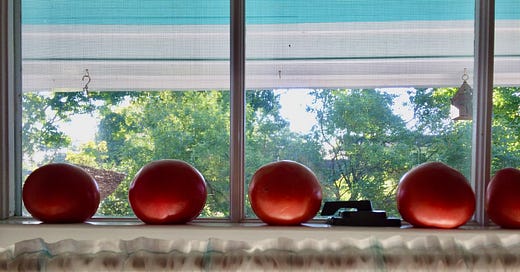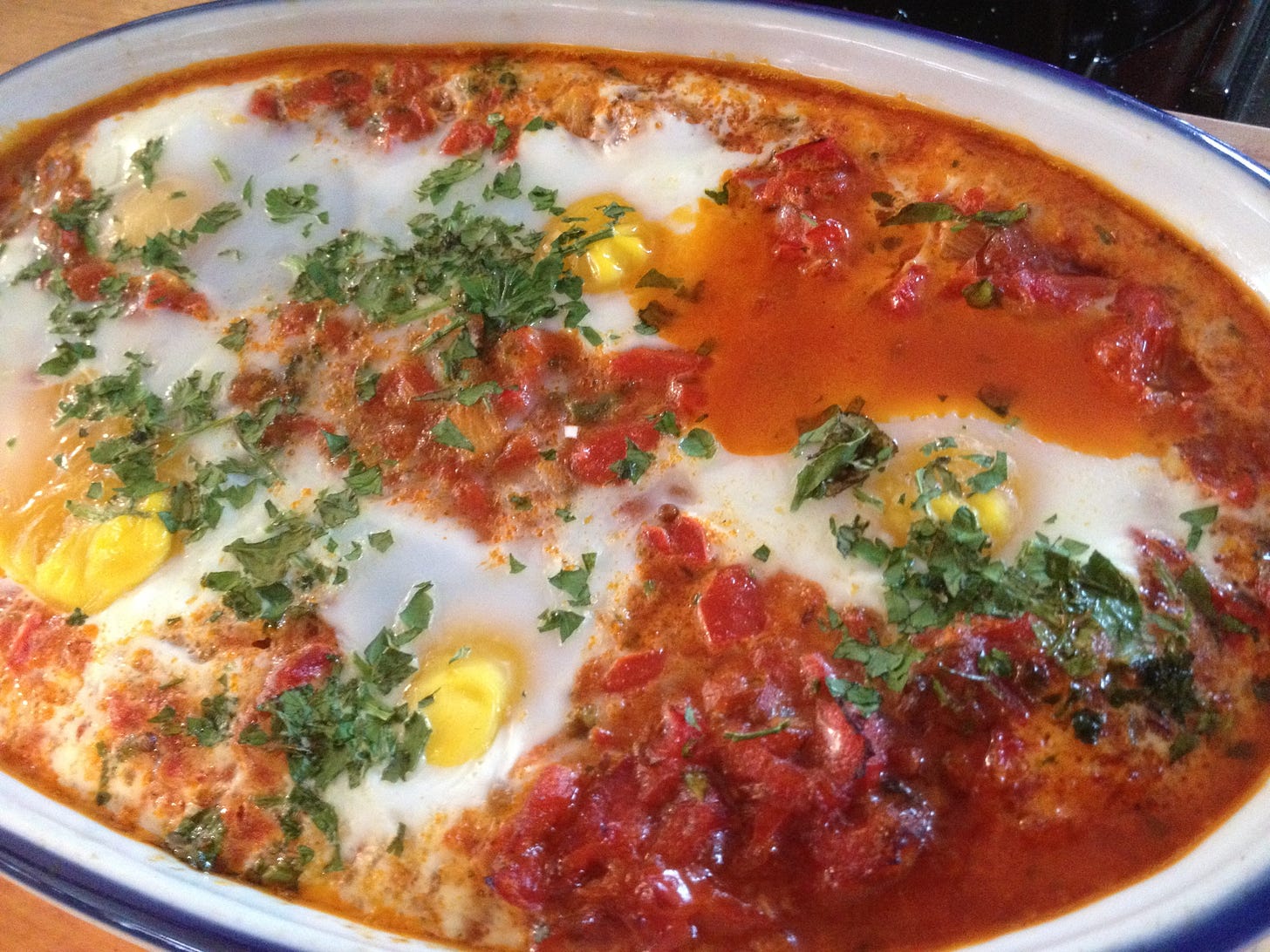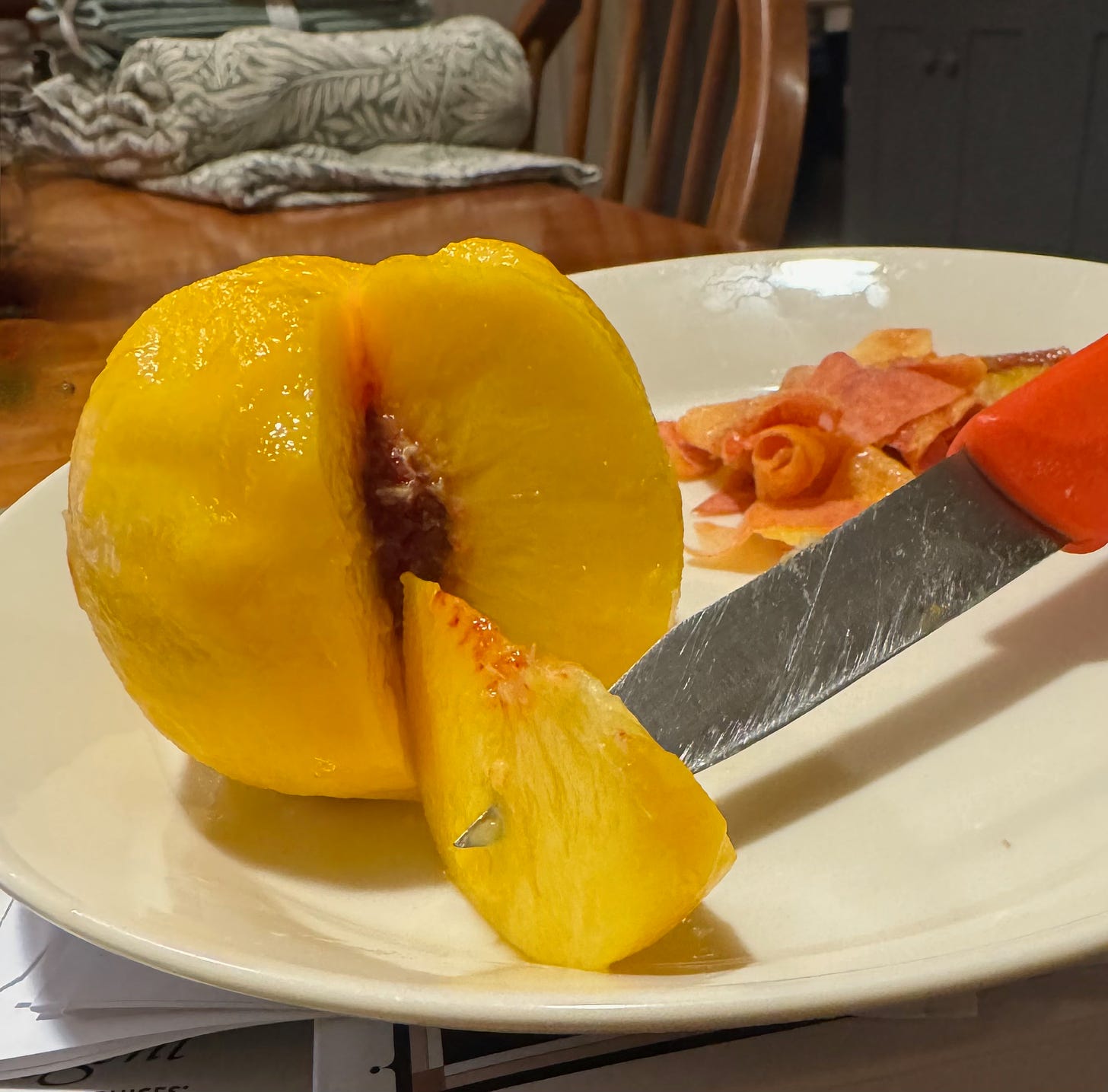Please take a moment to tap that little heart in the upper left corner. It shows you like what you’re seeing here. And thanks for joining me on my kitchen porch.
There are a few more hoops to jump through before tomato season ends. We still, fortunately, have a ways to go, even in Maine where the season is so darned short that most gardeners end up bringing in green tomatoes when the first frost threatens and lining them up on window sills to ripen in the sun. Ripen, I mean, in the sense of “turn red”—nothing will add sweetness and flavor to those late-season tomatoes and we’d be better off frying them up for fried green tomatoes for breakfast.
But I’m taking advantage of the late season to rustle up one of the most sensational dishes to come out of the Arab-Israeli breakfast world, shakshouka. Basically, this is a spicy North African sauce in which eggs are poached, steamed, or baked to make a substantial and very tasty breakfast, but keep in mind that it’s equally good for supper or for lunch. If you go to Israel, to the heart of the delightfully shabby old Palestinian city of Jaffa (which is swallowed up by Tel Aviv), you’ll find the dish in a restaurant of the same name, Dr. Shakshuka, where it’s sometimes served with fish fillets instead of eggs, a great idea. I’d try it with salmon, or even with salmon cakes.
There are variations: On the island of Pantelleria, midway between Sicily and Tunisia, it’s called sciakisciuka; island cooks add delicious Pantelleria capers to the sauce. I would do that. And I might also add a Sicilian touch with some roughly chopped black olives stirred in too.
You can make shakshouka ahead of time, even several days ahead, and refrigerate until you’re ready to reheat and serve. And don’t feel it has to be for breakfast—it’s a great energy booster at any time of day or night. Scroll down for the recipe.
One Perfect Peach
Last year we had no peaches on the coast of Maine. Late frosts killed off the buds just as they were forming. This year, as if in recompense, the peaches in our local markets are incredibly lush and sweet, as good as the ones from the Valdichiana in Tuscany, famous for peaches and melons. Clearly there’s something to the idea that stress produces flavor. Wise vineyard operators know that stressing the vines makes for wines with greater, more complex and seductive flavors, and the same operates for other fruits as well, especially stone fruits—peaches, plums, and the like. I could think of half a dozen things to do with these peaches—from pies to crumbles to cobblers. I even tried Julia Child’s directions for the old French farmhouse treat, clafoutis, marinating the sliced peaches in a cider liqueur from Canada, but the result was too sweet to bear, too sweet even for the dog who will eat almost anything. I ended up tossing it.
No, the better way to deal with perfect peaches is the way my daughter served them at the restaurant she had years ago on the Lower East Side (really-really lower, almost in Alphabet City). She put it on the menu as “one perfect peach,” and it was indeed that, straight from the farm, never refrigerated, and so ripe the fuzzy peel just lifted off. Served all by itself on a plate with a sharp fruit knife, and that was it. Honestly, what more could you ask for?
Deaths in the Family
I’m sad to report the deaths recently of three women who meant a great deal to me personally as well as to the world of people who care about food and wine. Lorenza de’ Medici died at 97 in Milan, and Clara Maria Gonzalez de Amezúa at 94 in Madrid.
Helen Gallo Bryan, on the other hand, died suddenly and unexpectedly from complications following surgery. She was in her mid-60’s, but I still think of Helen as she was when I first met her more than 30 years ago—young, enthusiastic, full of life, full of fun, curious, and eager to learn. We traveled together occasionally on her many wine trips to Italy (at the time she was working for Winebow), including an unforgettable trip to San Patrignano, an intentional community of reforming drug addicts in the mountains of San Marino, where some notable wines were created. Helen was eager for Winebow to import the San Patrignano wines but I can’t find any evidence that the company ever followed on her recommendations. I also saw her often when I lived in Boston, home base for her and her family. Helen’s warmth and generosity made any encounter with her memorable, whether over a great wine, a lousy coffee, or a humble slice of pizza. Without her, life seems a little less bright.
For Helen’s memorial service, a group of friends put together a small recipe collection. She was one of those intuitive cooks who seldom follow a recipe, but, they wrote, “There was ALWAYS a seat at her table.” I’ve included below (scroll down) Helen’s recipe for a rich and robust bolognese pasta sauce, to be served with a Chianti Classico or a Vino Nobile di Montepulciano.
Upper-class women were expected to be decorative foils for more or less successful husbands
Lorenza de’ Medici and Clara Maria Gonzalez de Amezúa de Llamas (her full name) were more formidable personalities, but still warm-hearted and generous with their friendship and their knowledge. Both women were born and raised in conservative times (and in deeply conservative social classes). In Spain and in Italy, upper-class women were expected to be decorative foils, auxiliaries to sustain and maintain more or less successful husbands, to produce a brood of children, an elegant table, and little else. And both of these women, in defiance of expectations, carved out long and distinguished if entirely unorthodox careers for themselves.
I don’t think Lorenza and Clara Maria ever met but I’m certain they would have liked each other and found a great deal in common and a lot to talk about. Lorenza’s focus in her writing and her teaching was on what she called “villa cuisine,” meaning the cooking of upper-class Italians who, despite their occasionally extravagant life styles, have their roots firmly in the countryside—in her case, in the vineyards, the olive groves, and the prolific gardens of her husband’s family estate, Badia a Coltibuono, in the heart of Chianti. I wrote about her back in 1987 in the New York Times, saying: “She is the epitome of a certain, unmistakably Italian chic. Tall, slender, handsome and quiet-spoken, on a recent visit to New York she wore a discreet string of pearls and an elegantly draped silk shirt, in sage green, selected perhaps to match the gray-green of her eyes. She carries one of the most eminent names in Italian history and is the doyenne of Badia a Coltibuono, a Tuscan wine estate that traces back its heritage a thousand years or more.”
Lorenza’s many books included The De’Medici Kitchen, based on a series she did for PBS television, and The Renaissance of Italian Cooking, with recipes from some of the most ancient and distinguished tables in Italy. (I’ve included one of her recipes below—scroll down to find it.)
As for Clara Maria, she was more broadly focused on all the foods and wines of Spanish gastronomy at a time when Spain’s culinary traditions were emerging from almost a half-century of Fascist isolation. It’s hard to explain to outsiders the revolutionary impact of El Alambique, the cooking shop and escuela de cocina that Clara founded in Madrid, but it was there at the beginning, as Spanish cuisine began to lift its head high alongside other more ballyhooed European traditions. A big part of El Alambique’s influence came from its founding mother; through her gracious hospitality and thoughtful instruction, so many of us, food writers and chefs, found enlightenment.
I had lived in Madrid, not once but twice, during the Franco years when the quality of food (and wine) in urban Spain was, I’ll put it politely, not something to flaunt. But with Franco’s death in 1975, Spain awoke and so did Clara Maria: El Alambique opened in Madrid just three years later and became Ground Zero for news, information, introductions, clarifications, recipes, techniques, and tools--and for a lot of good fun too. Clara was a devoted believer in Spanish gastronomy, advocating in Spain and abroad on behalf of talented young (and old too) Spanish chefs and food producers, as well as for regional traditions from the Basques to Andalucia to Catalonia and many lesser-known areas. And the world woke up to Spanish wines, cheeses, culinary traditions, and revolutionary new developments as well.
I cannot do better than quote from the obituary by my friend, and Clara Maria’s friend, Gerry Dawes, a prominent authority on Spanish food and wine, who called her a great ambassador for culinary Spain on the world stage, and one of the most elegant women in all of Spain: “Her enthusiasm for Spanish cuisine and willingness to share her knowledge with foreigners,” Gerry wrote, “have been of immeasurable importance as Spanish cuisine and Spanish chefs climbed the long hill to the culinary pinnacle where it stands today.”
May they all RIP.
Keep reading with a 7-day free trial
Subscribe to On the Kitchen Porch to keep reading this post and get 7 days of free access to the full post archives.






